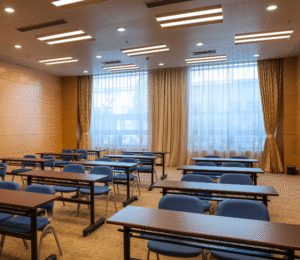In today’s fast-paced world, noise pollution is an ever-growing concern. Whether you’re working from home, running a business, or recording in a studio, external noise can be a significant distraction and even affect your productivity, health, and creativity. Fortunately, there are effective ways to block or reduce external noise from entering your space. In this blog, we’ll explore practical and professional solutions to create a quieter, more peaceful environment.
Table of Contents
Understanding Noise: The Basics
Before diving into solutions, it’s essential to understand how noise travels and what makes it challenging to block. Noise is essentially unwanted sound, and it can enter your space through three primary pathways:
- Airborne Noise: Sound waves traveling through the air (e.g., traffic, voices, or music).
- Impact Noise: Vibrations caused by physical impact (e.g., footsteps, construction, or slamming doors).
- Flanking Noise: Sound that travels through indirect paths like gaps, cracks, or structural elements.
To effectively block noise, you need to address these pathways using a combination of soundproofing techniques and materials.
Step-by-Step Guide to Blocking External Noise
1. Identify the Noise Sources
- Determine where the noise is coming from (e.g., windows, doors, walls, or ceilings).
- Assess the type of noise (airborne, impact, or flanking) to choose the right solutions.
2. Seal Gaps and Cracks
Noise can easily sneak through even the smallest gaps. Use these methods to seal them:
- Weatherstripping: Apply weatherstrips around doors and windows to create an airtight seal.
- Acoustic Caulk: Use acoustic caulk to seal gaps around windows, doors, and wall joints.
- Door Sweeps: Install door sweeps at the bottom of doors to block noise from entering underneath.
3. Upgrade Your Windows
Windows are often the weakest link when it comes to noise penetration. Consider these upgrades:
- Double or Triple Glazing: Install double or triple-pane windows with an air or gas layer between the panes to reduce noise transmission.
- Acoustic Window Inserts: Add laminated glass inserts to existing windows for an extra noise-blocking layer.
- Heavy Curtains: Use soundproof or heavy blackout curtains to absorb and block noise.
4. Soundproof Your Doors
Doors, especially hollow-core ones, can let in a lot of noise. Here’s how to soundproof them:
- Solid Core Doors: Replace hollow doors with solid core doors, which are denser and better at blocking sound.
- Door Seals: Install acoustic door seals around the edges to prevent noise leakage.
- Soundproof Blankets: Hang soundproof blankets over doors for a temporary solution.
5. Reinforce Your Walls
Thin walls are a common culprit for noise intrusion. Strengthen them with these methods:
- Mass-Loaded Vinyl (MLV): Add MLV to walls to increase mass and block sound.
- Acoustic Panels: Install acoustic panels to absorb sound and reduce echo.
- Drywall with Green Glue: Add an extra layer of drywall with Green Glue, a sound-damping compound, to reduce noise transmission.
6. Address Floors and Ceilings
Noise from above or below can be just as disruptive. Try these solutions:
- Carpets and Rugs: Lay down thick carpets or rugs to absorb impact noise.
- Acoustic Underlay: Install acoustic underlay beneath flooring to reduce footfall noise.
- Drop Ceilings: Add a drop ceiling with soundproofing materials to block noise from upstairs.
7. Soundproof Your Studio (For Musicians and Content Creators)
If you’re setting up a studio, you’ll need professional-grade soundproofing:
- Room Within a Room: Build a room within a room using resilient channels and soundproofing materials to isolate the space.
- Bass Traps: Install bass traps in corners to absorb low-frequency sounds.
- Acoustic Foam: Use acoustic foam panels on walls and ceilings to control reverberation.
8. Use White Noise or Sound Masking
Sometimes, completely blocking noise isn’t feasible. In such cases, masking it can be effective:
- White Noise Machines: Use white noise machines to drown out external sounds.
- Sound Masking Systems: Install sound masking systems in offices to create a consistent background noise that reduces distractions.
Additional Tips for Noise Reduction
- Furniture Placement: Arrange furniture strategically to act as a barrier against noise.
- Plants: Use tall, dense plants to absorb sound and improve acoustics.
- Bookshelves: Fill bookshelves with books and place them against walls to add mass and reduce noise.
Professional vs. DIY Solutions
While many soundproofing techniques can be DIY projects, some situations require professional expertise. For example:
- Installing acoustic windows or doors.
- Building a room within a room for studios.
- Complex wall or ceiling soundproofing.
If you’re unsure, consult an acoustic expert to assess your space and recommend tailored solutions.
Conclusion
Blocking external noise doesn’t have to be a daunting task. By understanding how noise travels and implementing the right techniques, you can create a quieter, more comfortable environment in your home, office, or studio. Whether you’re sealing gaps, upgrading windows, or installing acoustic panels, every step brings you closer to peace and quiet.
At Gitco-SA, we’re committed to helping you achieve the perfect acoustic environment. If you need professional advice or high-quality soundproofing materials, feel free to reach out to our team of experts. Let’s work together to silence the noise and amplify your productivity and creativity!


